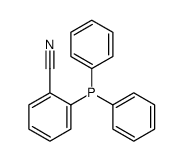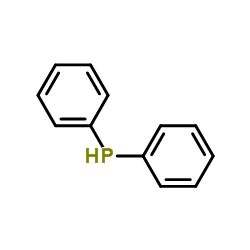2-(Diphenylphosphino)benzonitrile

2-(Diphenylphosphino)benzonitrile structure
|
Common Name | 2-(Diphenylphosphino)benzonitrile | ||
|---|---|---|---|---|
| CAS Number | 34825-99-5 | Molecular Weight | 287.29500 | |
| Density | N/A | Boiling Point | 427.7ºC at 760 mmHg | |
| Molecular Formula | C19H14NP | Melting Point | 150 °C | |
| MSDS | N/A | Flash Point | 212.4ºC | |
| Name | 2-diphenylphosphanylbenzonitrile |
|---|---|
| Synonym | More Synonyms |
| Boiling Point | 427.7ºC at 760 mmHg |
|---|---|
| Melting Point | 150 °C |
| Molecular Formula | C19H14NP |
| Molecular Weight | 287.29500 |
| Flash Point | 212.4ºC |
| Exact Mass | 287.08600 |
| PSA | 37.38000 |
| LogP | 3.31648 |
| InChIKey | FEOUZPAYKDNQBW-UHFFFAOYSA-N |
| SMILES | N#Cc1ccccc1P(c1ccccc1)c1ccccc1 |
|
Section 1: Product Identification Chemical Name:(2-Cyanophenyl)diphenylphosphine, min. 98% CAS Registry Number:34825-99-5 Formula:(NCC6H4)(C6H5)2P EINECS Number:none Chemical Family:organophosphine ligand Synonym:(2-Cyanophenyl)diphenylphosphane
Section 2: Composition and Information on Ingredients IngredientCAS NumberPercentACGIH (TWA)OSHA (PEL) Title compound34825-99-5100%no datano data Section 3: Hazards Identification Emergency Overview:Irritating to skin, eyes and respiratory tract. May be harmful if swallowed. Primary Routes of Exposure:Inhalation, skin, eyes Eye Contact:Causes mild to moderate irritation of the eyes. Skin Contact:Causes slight to mild irritation of the skin. Inhalation:Irritating to the nose, mucous membranes and respiratory tract. Ingestion:No specific information is available on the physiological effects of ingestion. May be harmful if swallowed. Acute Health Affects:Irritating to skin, eyes and respiratory tract. May be harmful if swallowed. Chronic Health Affects:No information on long-term chronic effects. NTP:No IARC:No OSHA:No SECTION 4: First Aid Measures Immediately flush the eyes with copious amounts of water for at least 10-15 minutes. A victim may need Eye Exposure: assistance in keeping their eye lids open. Get immediate medical attention. Wash the affected area with water. Remove contaminated clothes if necessary. Seek medical assistance if Skin Exposure: irritation persists. Remove the victim to fresh air. Closely monitor the victim for signs of respiratory problems, such as difficulty Inhalation: in breathing, coughing, wheezing, or pain. In such cases seek immediate medical assistance. Seek medical attention immediately. Keep the victim calm. Give the victim water (only if conscious). Induce Ingestion: vomiting only if directed by medical personnel. SECTION 5: Fire Fighting Measures Flash Point:no data Autoignition Temperature:no data Explosion Limits:no data Extinguishing Medium:carbon dioxide, dry powder or foam Fire fighters should be equipped with a NIOSH approved positive pressure self-contained breathing apparatus Special Fire Fighting Procedures: and full protective clothing. Hazardous Combustion andIf involved in a fire this material may emit toxic organic fumes. Decomposion Products: Unusual Fire or Explosion Hazards: No unusual fire or explosion hazards SECTION 6: Accidental Release Measures Small spills can be mixed with vermiculite or sodium carbonate or other non flammable adsorbent and swept Spill and Leak Procedures: up. SECTION 7: Handling and Storage Handling and Storage:Store the material in a cool, dry place in a tightly sealed container. SECTION 8: Exposure Controls and Personal Protection Eye Protection:Always wear approved safety glasses when handling a chemical substance in the laboratory. Skin Protection:Wear protective clothing and gloves. Ventilation:Handle the material in an efficient fume hood. If ventilation is not available a respirator should be worn. The use of respirators requires a Respirator Respirator: Protection Program to be in compliance with 29 CFR 1910.134. Ventilation:Handle the material in an efficient fume hood. Additional Protection:No additional protection required. SECTION 9: Physical and Chemical Properties Color and Form:white to off-white powder Molecular Weight:287.30 Melting Point:148-150° Boiling Point:no data Vapor Pressure:no data Specific Gravity:no data Odor:none Solubility in Water:insoluble SECTION 10: Stability and Reactivity Stability:air and moisture stable Hazardous Polymerization:no hazardous polymerization Conditions to Avoid:none Incompatibility:strong oxidizing agents and halogens Decomposition Products:carbon monoxide, carbon dioxide, phosphorous pentoxide, nitrogen oxides, organic fumes SECTION 11: Toxicological Information RTECS Data:No information available in the RTECS files. Carcinogenic Effects:no data Mutagenic Effects:no data Tetratogenic Effects:no data SECTION 12: Ecological Information Ecological Information:No information available SECTION 13: Disposal Considerations Disposal:Dispose of according to federal, state, and local regulations. SECTION 14: Transportation Shipping Name (CFR):Non-hazardous Hazard Class (CFR):NA Additional Hazard Class (CFR):NA Packaging Group (CFR):NA UN ID Number (CFR):NA Shipping Name (IATA):Non-hazardous Hazard Class (IATA):NA Additional Hazard Class (IATA):NA Packaging Group (IATA):NA UN ID Number (IATA):NA SECTION 15: Regulatory Information TSCA:Not listed in the TSCA inventory. SARA (Title 313):Title compound not listed. Second Ingredient:none SECTION 16 - ADDITIONAL INFORMATION N/A |
|
~83% 
2-(Diphenylphos... CAS#:34825-99-5 |
| Literature: Hingst, Martin; Tepper, Michael; Stelzer, Othmar European Journal of Inorganic Chemistry, 1998 , # 1 p. 73 - 82 |
|
~17% 
2-(Diphenylphos... CAS#:34825-99-5 |
| Literature: Wang, Yanchun; Lai, Chi Wai; Kwong, Fuk Yee; Jia, Wen; Chan, Kin Shing Tetrahedron, 2004 , vol. 60, # 42 p. 9433 - 9439 |
|
~92% 
2-(Diphenylphos... CAS#:34825-99-5 |
| Literature: Reis, Andreas; Dehe, Daniel; Farsadpour, Saeid; Munstein, Isabel; Sun; Thiel, Werner R. New Journal of Chemistry, 2011 , vol. 35, # 11 p. 2488 - 2495 |
|
~57% 
2-(Diphenylphos... CAS#:34825-99-5 |
| Literature: Koch, Guido; Lloyd-Jones, Guy C.; Loiseleur, Olivier; Pfaltz, Andreas; Pretot, Roger; et al. Recueil des Travaux Chimiques des Pays-Bas, 1995 , vol. 114, # 4-5 p. 206 - 210 |
|
~38% 
2-(Diphenylphos... CAS#:34825-99-5 |
| Literature: Kwong, Fuk Yee; Lai, Chi Wai; Chan, Kin Shing Tetrahedron Letters, 2002 , vol. 43, # 19 p. 3537 - 3539 |
|
~72% 
2-(Diphenylphos... CAS#:34825-99-5 |
| Literature: Zhao, Yu-Long; Wu, Guo-Jie; Li, You; Gao, Lian-Xun; Han, Fu-She Chemistry - A European Journal, 2012 , vol. 18, # 31 p. 9622 - 9627 |
|
~34% 
2-(Diphenylphos... CAS#:34825-99-5 |
| Literature: Erbe, Juergen; Beck, Wolfgang Chemische Berichte, 1983 , vol. 116, # 12 p. 3867 - 3876 |
| Precursor 8 | |
|---|---|
| DownStream 4 | |
| (2-cyanophenyl)diphenylphosphine |
| o-(diphenylphosphino)benzonitrile |
| Benzonitrile,2-(diphenylphosphino) |
| 2-(diphenylphosphino)benzonitrile |
| 2-(diphenylphosphanyl)benzonitrile |
| o-cyanophenyl(diphenyl)phosphine |










 CAS#:50777-76-9
CAS#:50777-76-9![(4s)-(-)-4,5-dihydro-2-[2'-(diphenylphosphino)phenyl]-4-isopropyloxazole structure](https://image.chemsrc.com/caspic/084/148461-14-7.png) CAS#:148461-14-7
CAS#:148461-14-7![(4S)-tert-Butyl-2-[2-(diphenylphosphino)phenyl]-4,5-dihydrooxazole structure](https://image.chemsrc.com/caspic/008/148461-16-9.png) CAS#:148461-16-9
CAS#:148461-16-9 CAS#:177263-77-3
CAS#:177263-77-3